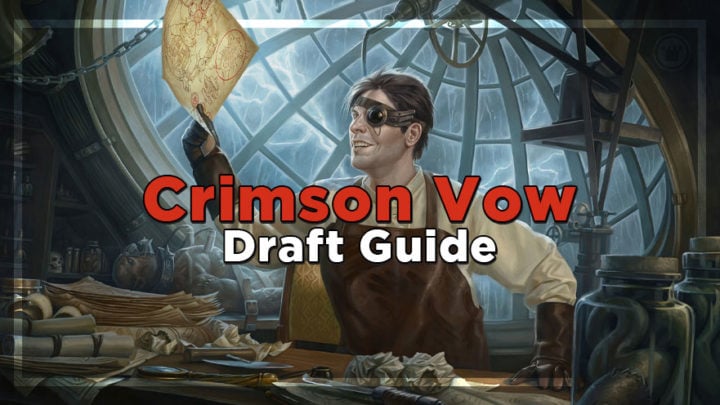Crimson Vow follows immediately on the heels of Innistrad: Midnight Hunt, without even a supplemental Draft product like Commander Legends or a Masters set to separate them. It’s been quite a while since we had consecutive sets share a thematic and mechanical base like this, and I admire how WotC has used this chance to express the grindy, graveyard-driven nature of Innistrad in two different ways.
If you read back through my Midnight Hunt Draft Guide, I characterized that Draft environment as “slow matches defined by board stall.” Crimson Vow still has a more methodical pace to its Draft games — in fact, I’d wager they’re longer on average than in Midnight Hunt — but this time, it’s because the board is close to empty!
Creatures in this set are stronger on average than the anemic bodies we saw in Midnight Hunt, but they’re still likely to trade in combat against anything within ~1 mana value of them. Removal is plentiful across all colors (barring blue), well-costed, and usually unconditional! But crucially, that removal is often slanted toward defensive use, rather than allowing aggressive decks to shove aside blockers as we’ve seen in Adventures in the Forgotten Realms or Strixhaven. Countermagic, bounce spells, and other tempo plays are relatively low in number and power, too, especially compared to the last set!
SUNLIGHT RETURNS; NATURE IS HEALING
In another stark contrast to the grim, wilted world of Midnight Hunt, this set has boatloads of lifegain and card selection — again, spread across most colors. This gives you more time to draw out of most bad situations, as well as more chances to do so. There’s also better and more widely-available mana fixing, the majority of which also ramps; on the whole, I’ve found splashes less necessary and less awkward in this format. All of this increases consistency even further and leads to hard-fought matches.
Between this strong removal and mechanics like disturb or training — which encourage players to attack often and trade creatures aggressively — it’s common for each side to have 0-3 creatures at a given time. So when you’re evaluating your possible picks, try to imagine which cards perform best in small-board situations. There’s a reason the only common edict effect costs you five mana and a creature!
DRAFT ARCHETYPES – COLOR BY COLOR
Anyway, we can go into more detail for how this playstyle affects each color in their respective sections. So here they are: your Innistrad: Crimson Vow Draft archetypes!
GREEN-BLUE: SELF-MILL (AND SPLASH VALUE)
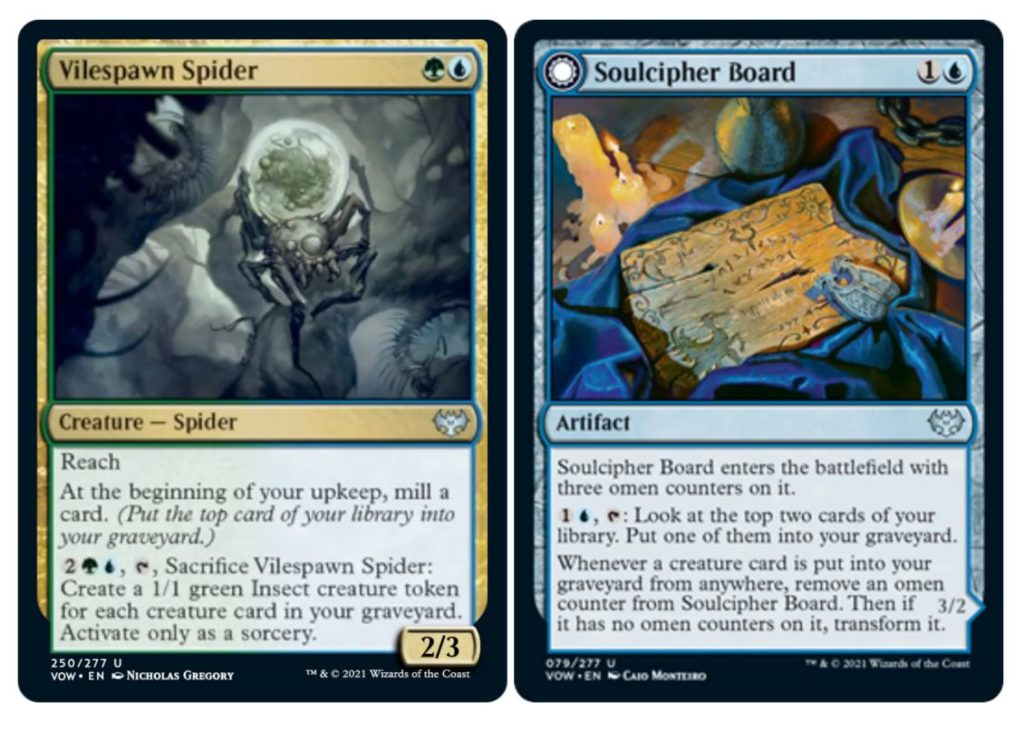
Somewhere early in the Crimson Vow design meetings, I imagine somebody went up to the whiteboard and just wrote “SPIDER SPAWNING” in huge block letters. Then they underlined it, and circled it a few times, and put little fireworks coming off the side.
Players have spent 10 straight years raving about how much they love Spider Spawning in Draft. So WotC took the easy win and made the whole UG archetype in that mold. You can actually get away with negative-tempo effects like Mulch when your payoffs are as good as these!
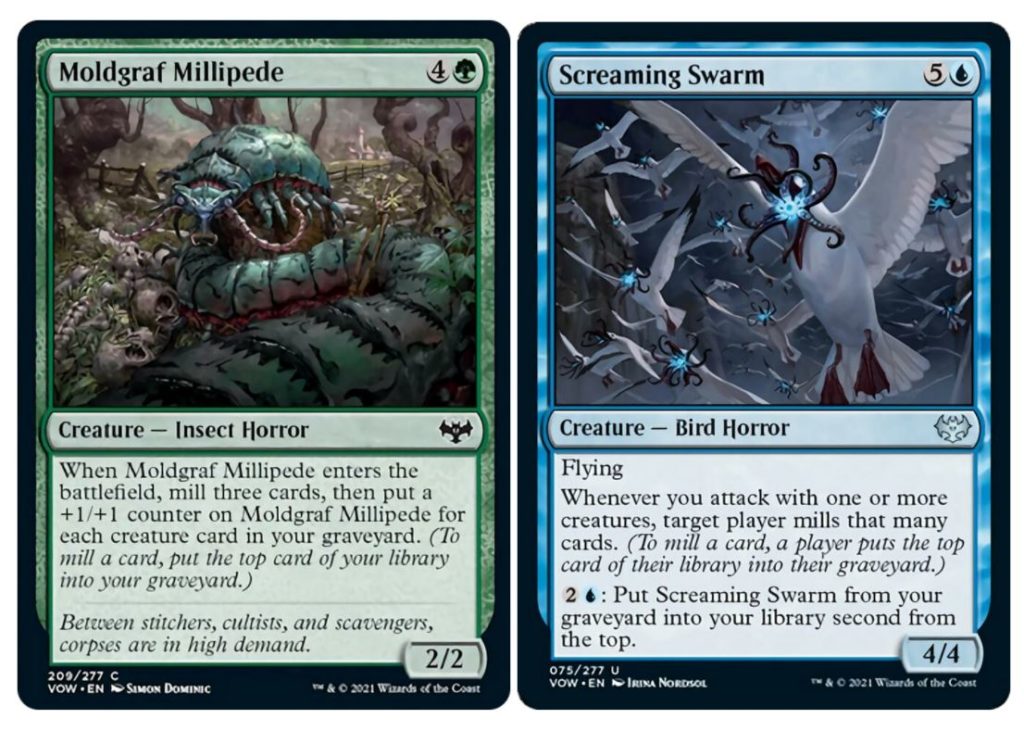
Green has the majority of the actual milling effects (although blue’s draw effects tend to have a looting component), but blue is equally important in this archetype. Take advantage of blue disturb creatures or others like Cobbled Lancer that are active from the graveyard; they’ll give you the chance to mill INTO a payoff even with none in hand! Binding Geist is a well-costed stopgap to slow early bleeding or de-fang deathtouch blockers, so your huge Millipedes can swing in safely. Lantern Bearer and Gutter Skulker are less flexible but excellent in combination with green threats, setting up very fast clocks once you’ve turned the corner.
P.S. These are once again the best colors to play if you’re interested in some sort of rainbow value deck. UG naturally extends the game and has by far the best card selection to find those bombs. Instead of huge flashback spells, you’ll be vacuuming up all the unwanted copies of Retrieve, which has been going later and later in my pods. The card basically says “Return target rare creature and the land you need to cast it”! Plus, you can use it to recur Sigarda’s Imprisonment if you splash white, which is great for ploughing through any opposing bombs they may draw while you drag things out.
BLUE-BLACK: ZOMBIE EXPLOITS
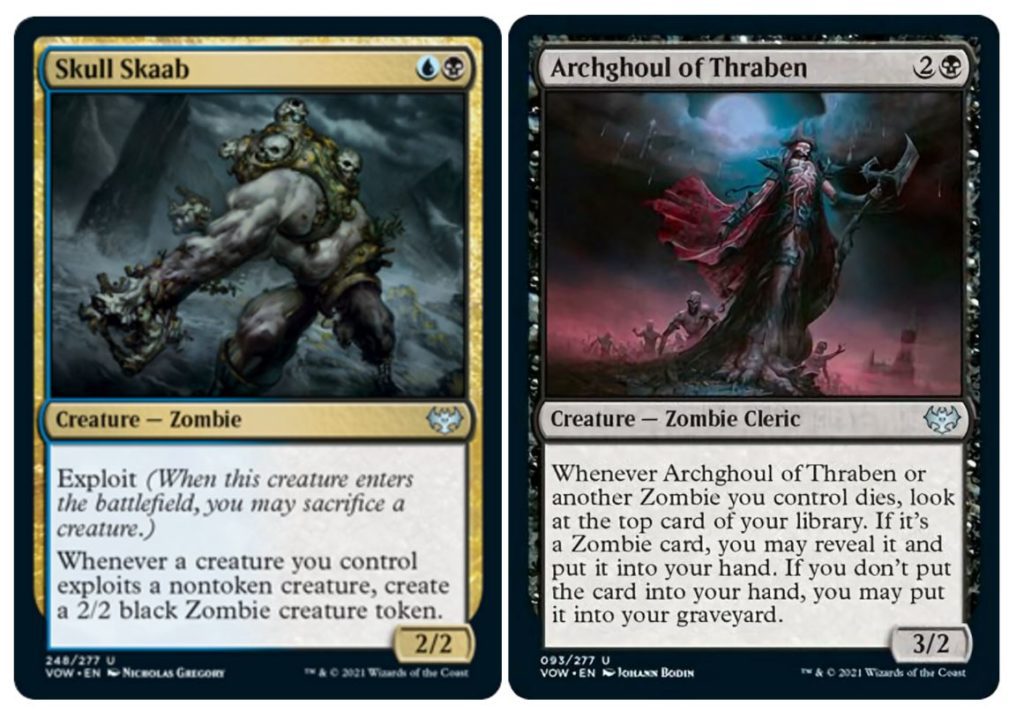
Not everything about the logic of Limited has changed since Midnight Hunt: the UB deck is still Zombie aggro, and it is still extremely good. But the balance of the archetype has swung back toward creature cards; instead of nasty tempo tricks which come with a bonus Zombie, we’re casting Zombies with optional bonus tempo tricks.
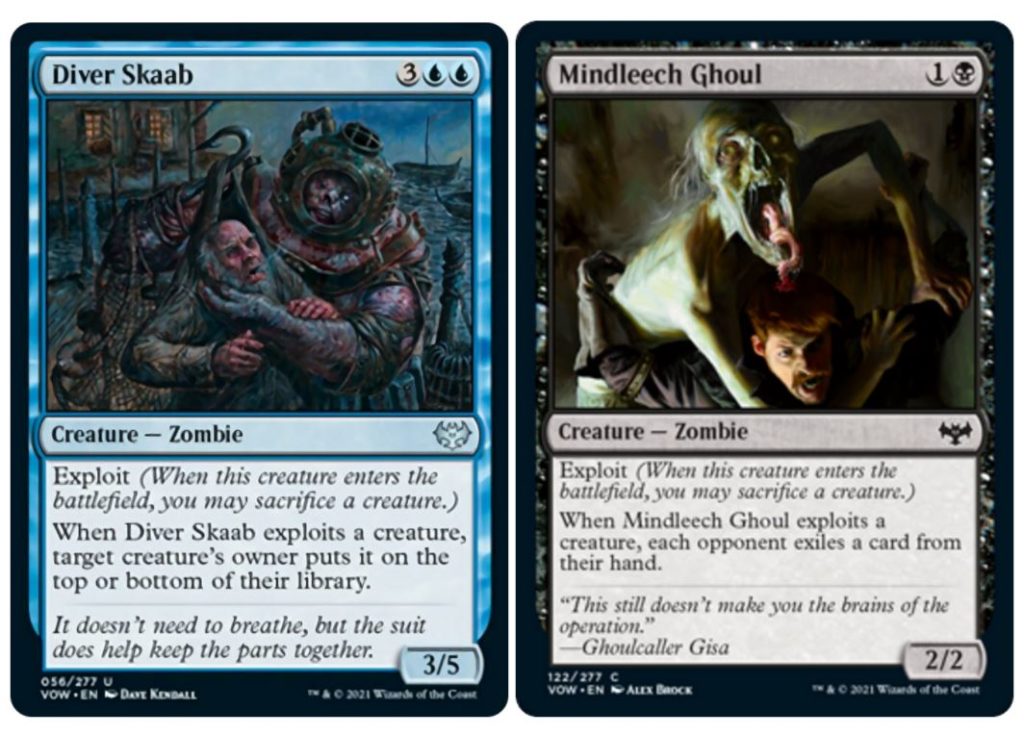
I never expected to love exploit as a Draft mechanic, but it is wonderfully balanced within the context of this set. Bodies on board are very important, and without decayed tokens around, the sacrifice cost is harder to blow off. This means making some tough decisions about prioritizing a strong board vs. short-term advantage; I’ve fed Diver Skaab and Rot-Tide Gargantua to themselves more than once so I could get off an attack with my 2/2’s! You’ll also want to prioritize cheap, aggressive bodies and a few of those expensive exploit-ers (or Bleed Dry, to recur with Repository Skaab) to set you up for such plays.
Of course, most of the goals for this archetype involve sweetening those tradeoffs. Skull Skaab is a super-efficient value engine in a set with less of those than usual, quickly snowballing games if you’re able to curve out with exploit cards. Archghoul of Thraben is nearly as powerful, adding value to other Zombies like Diregraf Scavenger and Wretched Throng. Speaking of the Throng, it and Persistent Specimen give you ways to — uh, exploit your sacrifice effects even at common. But don’t expect them to wheel; a steady stream of Goblin Pikers turns out to be great in every blue deck in this set!
BLACK-GREEN: TOUGHNESS MATTERS
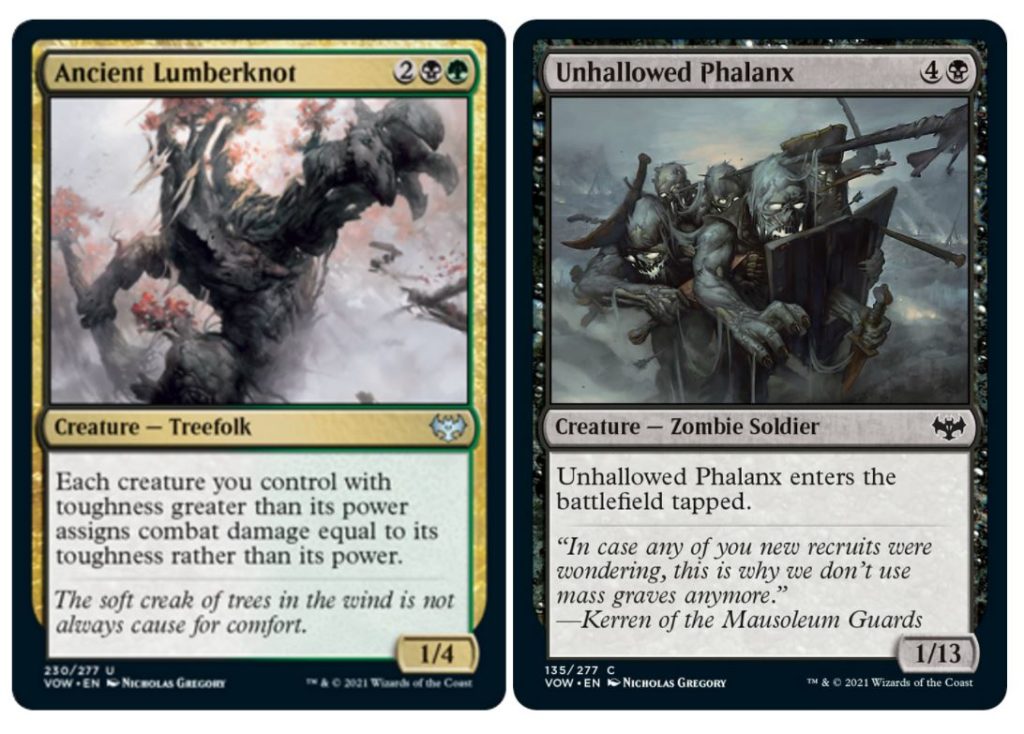
Another archetype theme which is sure to please the crowd, black-green supplements its usual midrange credentials with some spicy combos involving high-toughness creatures! WotC has tried slipping a single effect along the lines of Ancient Lumberknot into prior sets to tempt us, but adding a redundant threat in Catapult Fodder and a playable common payoff in Unhallowed Phalanx means you can actually make this your Plan A for closing out games!
Every green creature above three mana is tough enough to work with, so you can just chuck Catapult Fodder into a pile of miscellaneous creatures and removal as an alternative closer. But if you’re committing to the plan early, you can get ambitious: use green self-mill to dig toward your combo pieces, and black effects to return them to hand. Blood Fountain, Gluttonous Guest, and Courier Bat (plus Bleed Dry) are the ideal foundation of every slow black deck in Crimson Vow, but they may be at their very best here.
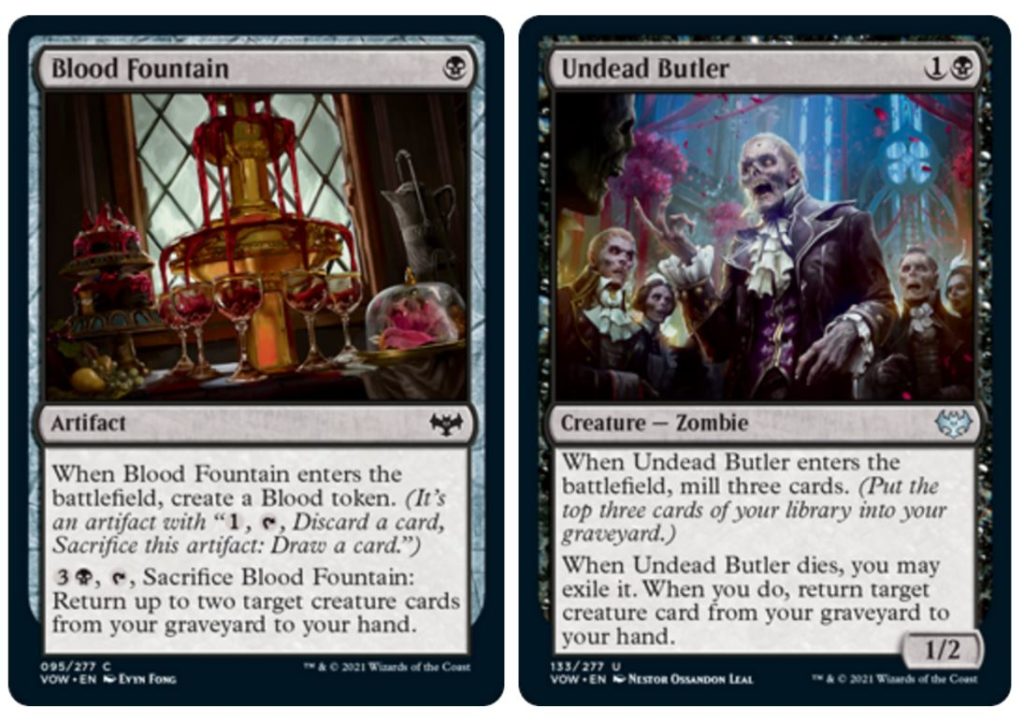
There are a couple more cards in each color that shine in this archetype. The insect tokens from Crawling Infestation and Infestation Expert find their best use as fuel for black’s exploit effects. And Bramble Wurm is an ideal target for Edgar’s Awakening or Undying Malice — so much so that I’ve eagerly taken it to splash even in non-green black decks.
RED-GREEN: WEREWOLVES
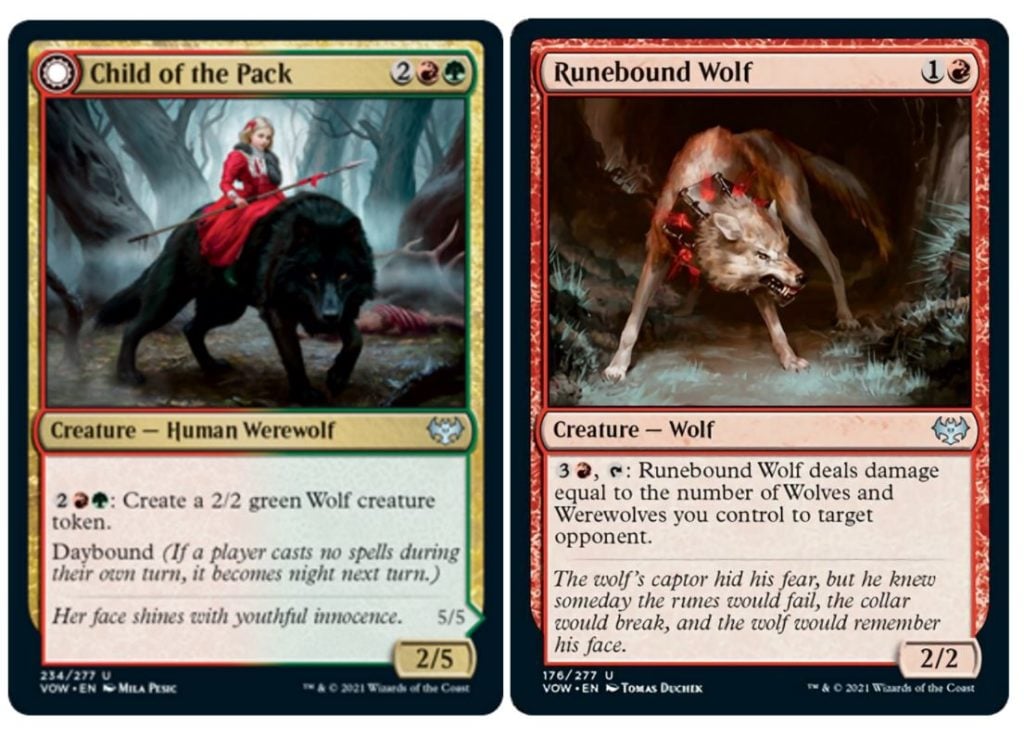
Good news for Werewolf fans: your creatures are much, much better statted in Crimson Vow than they were in Midnight Hunt, and other players are no longer rewarded for you setting it to night-time. The bad news: this deck is still mediocre unless you have on-theme rares and top uncommons. It’s an uphill battle to play an archetype so predicated on attacking with superior creatures when the set is full of cheap, unconditional removal. And with lifegain all over the place, your opponents can afford to multi-block and kill your biggest Wolf on every attack, making it hard to sustain momentum.
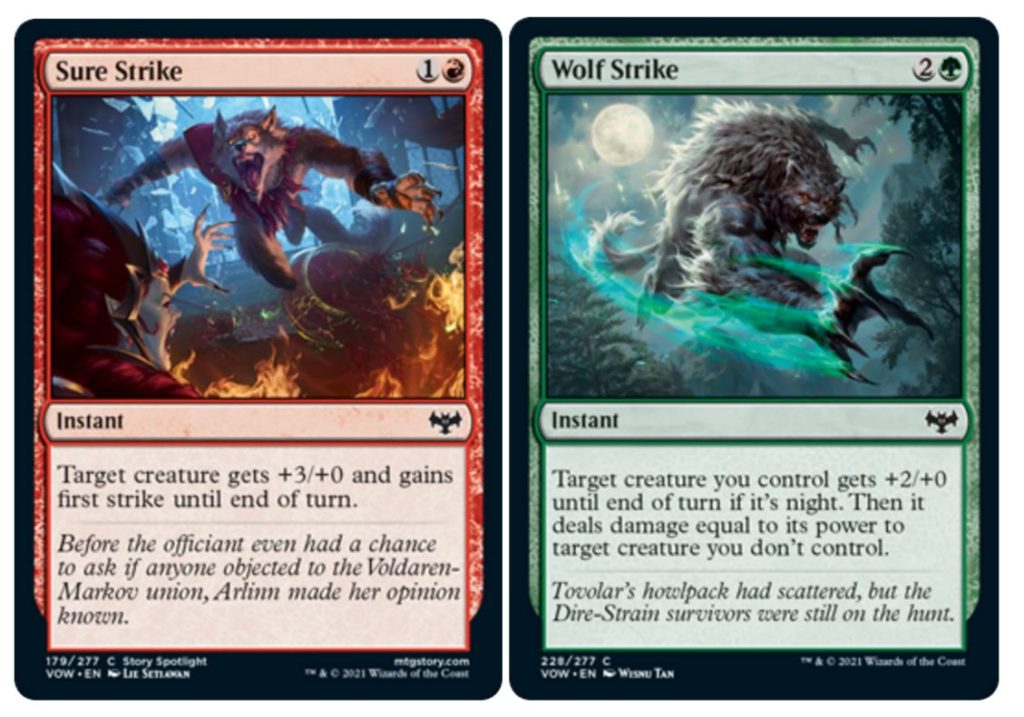
However, there are still some important ways to improve your odds. First, cheap instant tricks which punish those multi-blocks — there’s a reason they gave Sure Strike Werewolf art this time around! Wolf Strike is even harder to get, as it’s green’s best common and only real piece of removal, but it’s well worth taking highly.
Secondly, any mana sink you can find in this set is tremendous for RG. These cards will allow you to pivot from risky attacking to safe blocking while accruing turn-on-turn advantage. Your size advantage is much harder to overcome when you’re the one assigning blocks, and your counterpunch into a reduced force of blockers is incredibly scary. Being able to expand your board with Child of the Pack or chip away at them with Runebound Wolf and Ballista Watcher completely transforms this archetype into one worthy of pursuing. It’s just a shame most such effects are on rares (or a P1P1 uncommon like Ballista Watcher); you essentially have to wait for those picks to start looking at a potential RG draft.
WHITE-GREEN: HUMAN SQUAD, ASSEMBLE!

I really admire the design of this archetype. For something so straightforward and specific, there are a number of sub-branches that can each appear together, or be siloed off into decks with other colors and synergies. There’s the training mechanic and the natural synergies which allow you to reliably trigger it. There are also +1/+1 counter synergies, which also happen to be training synergies. Then there’s some support specifically for Human tribal… but of course, every creature with training is also a Human. Navigating to the center of this Venn diagram is step one of succeeding in GW.
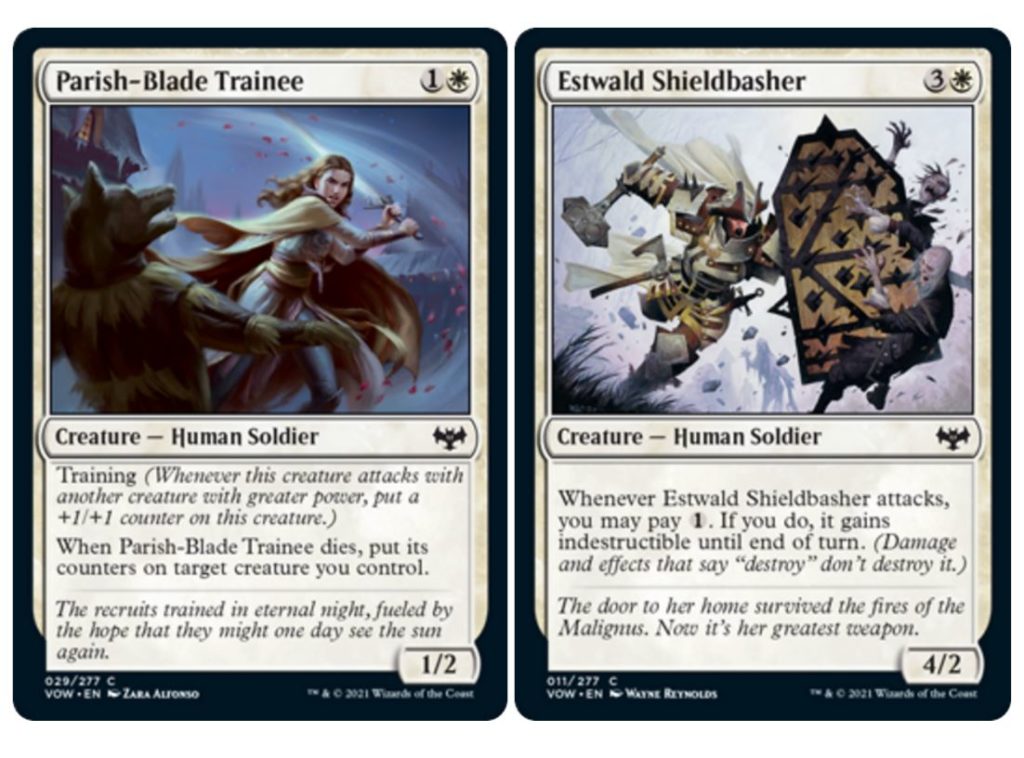
Step two, which I had to learn the extremely hard way, is that the GW training creatures do NOT attack like traditional aggro creatures, even if you’re casting them on curve. Instead, you’ll want to assemble a wide attack force of Humans led by Estwald Shieldbasher or Sigardian Paladin, and then chunk away the enemy’s life total in a couple of alpha strikes. Shieldbasher in particular deserves special praise; it really is just The Abyss for 3W, and you can pretty easily forgo the other training stuff if you can draft two or three of them with some OK blockers to hold down the fort.
I hint at skipping the training cards because the otherwise-excellent Shieldbasher fails to cover the glaring weakness of Parish-Blade Trainee: decks that pressure you while you’re trying to get your squad assembled. It’s nearly impossible to find a favorable block for Trainee or Gryff Rider, and Apprentice Sharpshooter is only a little better. You can help things along with buffs like Bramble Armor or Sheltering Boughs, but then you risk being even further behind if they hit you with removal. (Most removal in this set doesn’t care how big your creature’s stats are!)
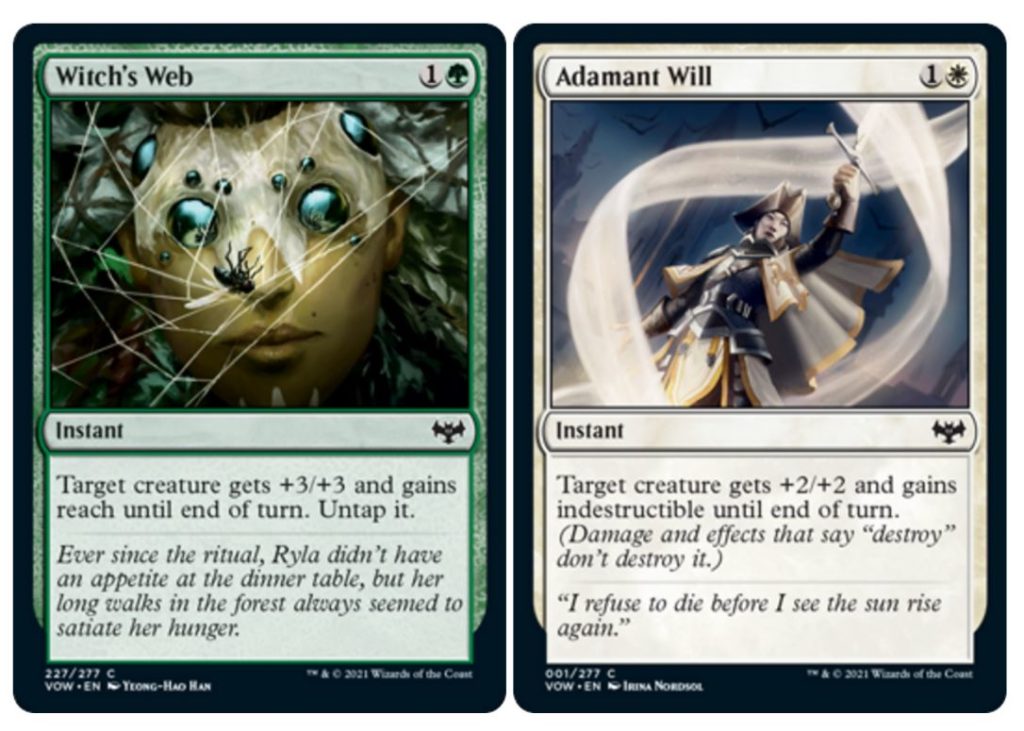
This makes Militia Rallier the all-important secret sauce for a training-focused deck. The 3/3 blocker resists cheap removal like Piercing Light, Gift of Fangs, Vampires’ Vengeance and Flame-Blessed Bolt; it forces a trade for their attacker at worst and generally slows things down so you can get your house in order. Green creatures like Hookhand Mariner are also good defenders to mix into your curve; remember that all the werewolves are still humans on their front side. And perhaps the safest option is to fill the middle of your curve with removal; the two modes of Fierce Retribution just happen to align with the timing of GW’s squad-based gameplay.
BLUE-WHITE: DISTURBING AURAS

The disturb deck is once again sitting close to the top of the archetype power rankings — but like UB Zombies, there are a lot of changes to the playstyle hiding under the re-used set mechanic. Disturb itself is notably different in this set: every creature has an Aura on its reverse side, so you can’t just mill them until you have an endless supply of attackers. Instead, you want to use the inherently trade-happy nature of disturb to mix-up opponents; they’ll have to guess whether you’re baiting them to block into Adamant Will or just eager to redistribute Drogskol Infantry’s stats onto a waiting flyer.
Such flyers are still pretty exclusive to these colors, with Courier Bat the only outside option below rare. Reach is limited, too, outside of Apprentice Sharpshooter. But the removal available for your air force is much more efficient compared to Midnight Hunt, and the forces racing you on the ground have almost doubled in size while you’re still juggling 1/1’s and 2/1’s. You’ll need something extra to change that math, but luckily, there are options.

Aside from the universally good removal, you can survive with lifegain from Kindly Ancestor and Dawnhart Geist, or just chump efficiently with Spirits from Brine Comber, Heron-Blessed Geist and Whispering Wizard (which triggers from the Aura side of disturb creatures). Blue’s limited tempo tools are at their best here when you don’t have all the white removal, particularly when you can exploit a disturb creature or a Spirit token for Diver Skaab.
But if all else fails, just gumming up the ground with Steelclad Spirit and Militia Rallier while extending the top end with Cruel Witness, Skywarp Skaab and Screaming Swarm allows a less all-in approach to combat. The depth and consistency are what really elevate this archetype both in the draft and in the games.
RED-BLUE: SPELLCASTER TEMPO

Crimson Vow is shaping up to be a real test for veterans of the classic “spells matter” Draft playstyle. Which is not to say that UR is weak or unpopular, but you may need to depend on some of the set’s most fiercely-contested cards.
The big destabilizing factor for UR is that these colors sit dead-last among Crimson Vow archetypes for reliable removal. Flame-Blessed Bolt, Vampires’ Vengeance (a.k.a. “Vampyroclasm”) and even Lacerate Flesh are positioned as combat tricks rather than efficient 1-for-1 answers. That leaves you to fight every red drafter (and plenty of splashers!) for copies of Abrade and Rending Flame. Blue has also lost its usual “creature doesn’t untap” Aura removal, which is replaced by the so-so Fear of Death. Blue’s counterspells are limited, too, and they’re relatively easy for your opponents to play around.
Be extremely careful playing with Syncopate on Arena; any untapped Island will reveal its presence in hand to your opponent and make it vastly harder to use.
This extreme lack of tools to deal with creatures above two toughness means that even the archetype themed around noncreature spells is forced to proactively deploy bodies — even more aggressively than some other decks in the format. Even if you’re just stalling until you draw your Hullbreaker Horror or Olivia’s Attendants, having serviceable blockers is imperative to ensuring you can play your other spells reactively — the way UR can in other formats.
The second tricky part is figuring out how to actually win the game. Unless you have a truly unbeatable bomb, you’ll usually need an evasive curve-topper; the slow trickle of damage from Kessig Flamebreather and Lambholt Raconteur won’t be enough. I say “curve-topper” because you’ll usually only want to spare one creature from blocking duty; Cruel Witness is the prime candidate, but heavily contested by blue drafters. Backup threats include Gutter Skulker, Lantern Bearer enchanting Falkenrath Celebrants, or the excellent Biolume Egg plus any exploit-er.
WHITE-RED: CURVE-OUT AGGRO
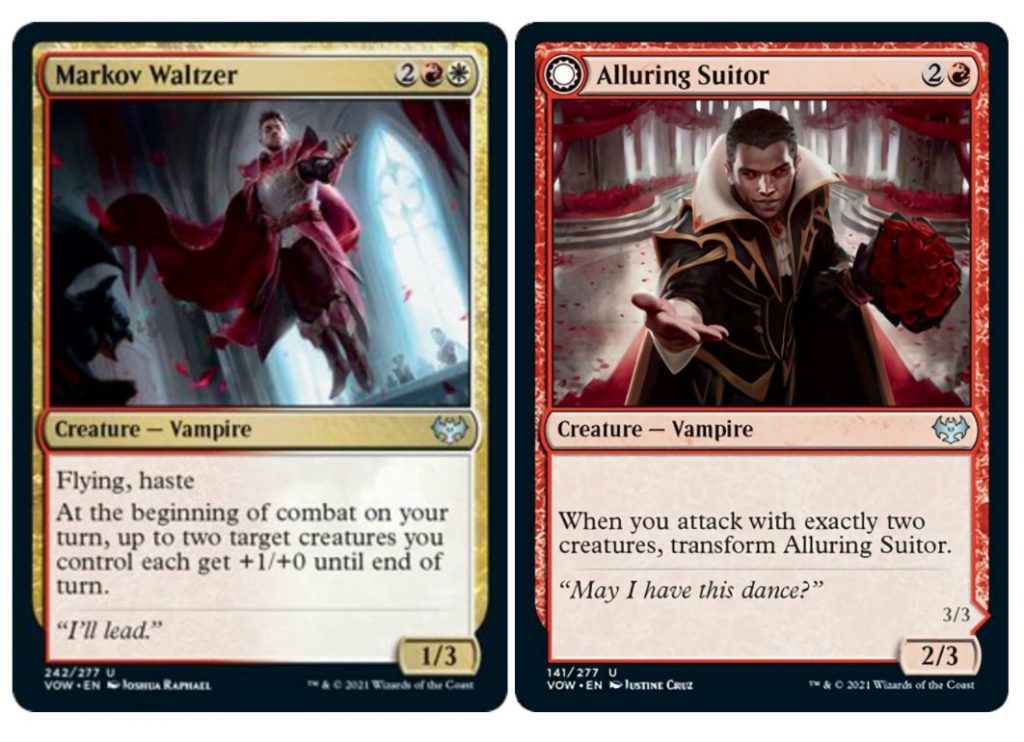
Normally, I’d be a little disappointed to see one of my favorite color combinations saddled yet again with the “vanilla” of themes. But judging by how curve-out aggro plays in this format, the WR deck is more like the decadent, blood-infused vanilla treat you’d expect at Innistrad’s most exclusive Vampire wedding. Almost every card in these colors gives you a little bit extra when you’re on the attack, and some give you quite a lot. Add in higher quality aggressive creatures overall — especially compared to the travesty that was red in Midnight Hunt — and you’ve got an archetype that can really speedrun Draft games.
The philosophy for your picks is simple in concept, but takes discipline and awareness to stick to. More than anything else, you need to pack as many high-quality two- and three-drops as you can, with a smattering of expensive finishers and one- or two-mana tricks. Attackers with first strike and/or good stats mean you can save your tricks for blowing opponents out instead of just forcing attacks through. Lifelink, trample and haste help you win the race against other aggressive archetypes. Evasive keywords like menace or flying are less useful, unless they’re on your biggest threat.
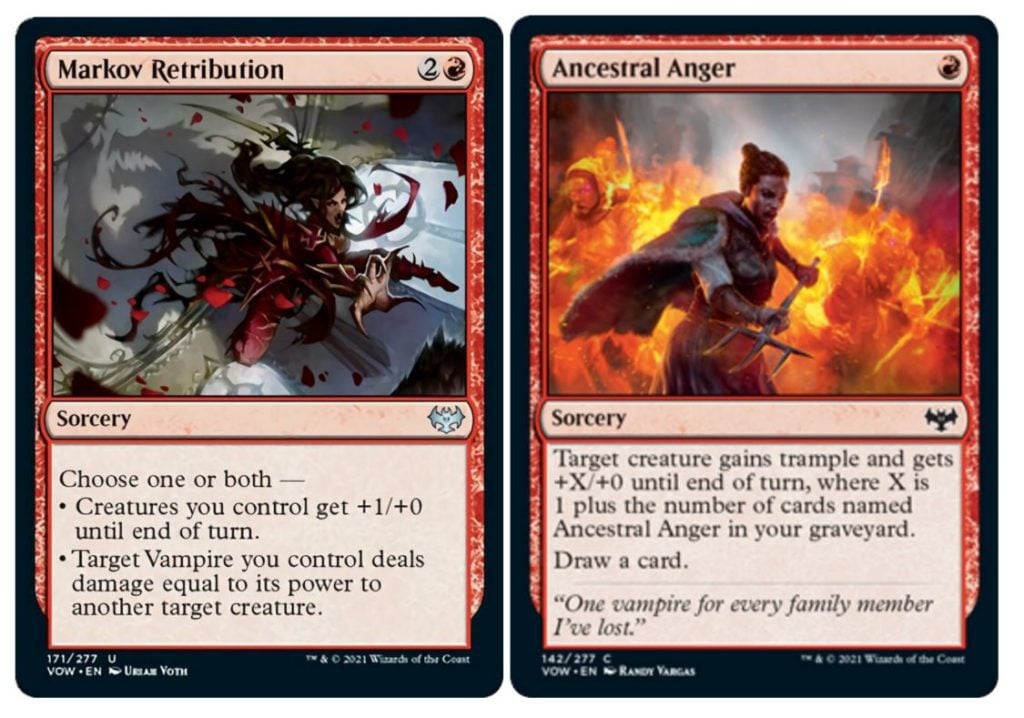
I like to go heavy into red, where most of the creatures you want are Vampires. Blanking Gift of Fangs and Vampires’ Vengeance (not to mention unlocking it as a devastating option for yourself) is a considerable upside, as are any incidental Blood tokens that can help you find the right spell to close things out. But white does offer some alternatives: Drogskol Infantry continues to be probably the best two-drop in the set, Fleeting Spirit only needs one first strike activation to punish opponents, and Estwald Shieldbasher is as mighty as ever — mightier, when you can throw Ancestral Anger on it every other turn! Special shoutout to Distracting Geist and Frenzied Devils, both of which are exclusively good here and fairly easy to come by for their rarity.
RED-BLACK: BLOODY VAMPIRES

After a mediocre showing in Midnight Hunt, the Vampire colors of red and black are at their best under the spotlight of Olivia Voldaren’s wedding. In addition to a full curve of generously-statted vamps, this deck gets the most use out of Crimson Vow’s defining mechanic: Blood tokens. Whether you’re simply looting away your unwanted eighth land, boosting the power of a lethal attacker, or operating a perpetual Blood engine, these little artifacts are a ton of fun.
One cool thing about this archetype is the flexibility of how you pace your game plan. It’s really more like two archetypes, forming either end of a scale. On the low end, you can play a game remarkably similar to the RW deck, except with more emphasis on removal to prevent good blocks on your menace and trample creatures. On the higher end, you can play a pretty mean control game with lots of bonus Blood value, lifegain, and removal spells like Bleed Dry and Grisly Ritual. I’ve had success going heavily one way, heavily the other, and everything in between. There isn’t even much difference in which cards work with which plan; you can easily figure it out once you see what’s in your pool.

Skulking Killer is a card I was very harsh on to start with, but I’ve reluctantly agreed that it finds a place in removal-rich red-black decks. You already want to trade one-for-one as much as you can while stabbing away with Falkenrath Celebrants or Bloodcrazed Socialite; that’s the sort of play which will trigger Killer, and all you need from it afterward is to trade off with whatever blocker they play next.
Innocent Traveler is another card that’s passed over by other decks, but when you’re already pressuring both hand and board, the trigger feels a lot more devastating. Same story for Rot-Tide Gargantua, which can definitely slot in over the Vampire five-drops if you aren’t high on tribal synergies. Lastly, please draft (and then remember to use) Sanguine Statuette. It triggers even when you’re using Blood to pay for Wedding Security or Bloodcrazed Socialite!
BLACK-WHITE: LIFE CONTROL

Another color combination, another somewhat-tired Limited playstyle reinvigorated by the excellent card design of this set. The life deck is back and just as durdly and trigger-value-happy as you could ask. But this time — thanks mostly to Blood tokens — it’s actually good!
What I like the most about this lifegain deck is how rarely it cares about gaining life. Markov Purifier is a great card, but you’re lucky to get more than one in a draft, and it’s often killed on sight. Panicked Bystander, Restless Bloodseeker and Courier Bat would all really appreciate it if you gained some life around the time they’re played, but at worst, they’re acceptable creatures on rate. Same with our other transforming creatures, Desperate Farmer and Ragged Recluse. You’re rarely going to max out their value, but when you don’t really need to, you have license to run the first couple out and rely on the remaining ones to carry the game.
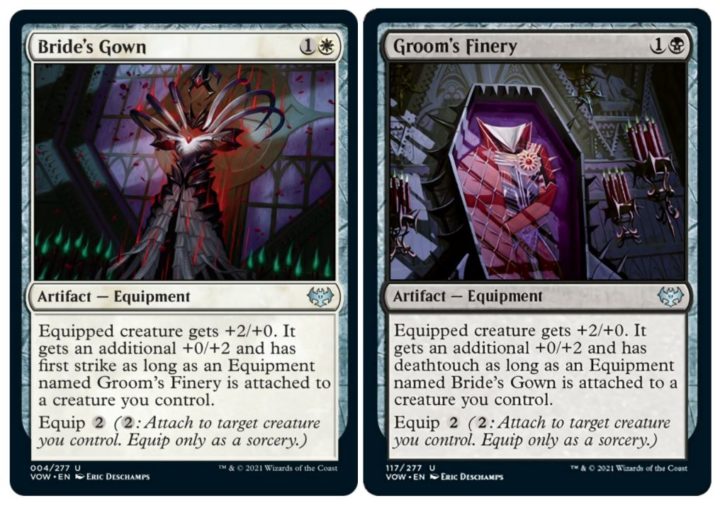
I just rattled off a lot of early synergistic creatures, and you can definitely steal games with them. But you mostly want to react to your opponent’s pace. If they do nothing on board, attack with everything. If they commit heavily to the board, play defense and force them to swing into multi-blocks (or deathtouch from the awesome Diregraf Scavenger or a flipped Bystander). Use the removal suite in these colors to shrug off anything too nasty to fight. Use your burgeoning life total to absorb any attack which threatens to blow you out. Use your Blood tokens to loot away any dead cards; one of the most valuable skills for this set in general is knowing when to save your cards to rummage away (or if you need to discard to Bloodsworn Squire or an enemy Mindleech Ghoul).
The only really tough question these decks sometimes face is how you’re going to win — especially if your opponent has also gained a considerable amount of life. One surprisingly valid answer is just decking your opponent! Crimson Vow Draft games end in deck-out quite a lot thanks to the slower pace of play and hugely increased draw power provided by Blood tokens. Given your ability to dictate both the pace of the game and your own draws, you can judge whether a game is ripe for decking and then play miserly with your resources until you’ve absorbed every last drop from your opponent’s neck… uh, deck.
SOMETHING BALANCED, SOMETHING BLUE
That’s all the Crimson Vow Draft tips we’ve got space for, at least this week. I’ve had a tremendous amount of fun with every one of these archetypes; the set is really well balanced, and the consistency and extra choices built into mechanics like Blood tokens and disturb improve game quality even more than similar attempts across the last few years. That’s right, Blood tokens are cooler than MDFCs — you heard it here first!
One last piece of advice I feel obliged to include: I do find that base-blue decks add about 20% winrate over other color combinations. While it doesn’t feel as lopsided as playing against UW or UB in Midnight Hunt Draft, the cumulative power-up to cards like Syncopate, Diver Skaab, Chill of the Grave, Lunar Rejection, and Lantern Bearer once you’re ahead is very difficult to resist. Plus, they have a lot of high-ceiling cards in Biolume Egg, Soulcipher Board, Whispering Wizard and Stormchaser Drake — any of which will randomly win games in their respective archetypes. I think ultimately giving two colors exclusive ownership of flying in these Innistrad sets has proven too good, if only slightly. So if you’re just trying to grind out wins, I recommend starting your drafts with eyes on blue, and Esper more generally.
I hope you’ll all join me again next week, when we’ll have the extra experience and data to take a more scientific look at how to succeed in Crimson Vow Draft!

Tom’s fate was sealed in 7th grade when his friend lent him a pile of commons to play Magic. He quickly picked up Boros and Orzhov decks in Ravnica block and has remained a staunch white magician ever since. A fan of all Constructed formats, he enjoys studying the history of the tournament meta. He specializes in midrange decks, especially Death & Taxes and Martyr Proc. One day, he swears he will win an MCQ with Evershrike. Ask him how at @AWanderingBard, or watch him stream Magic at twitch.tv/TheWanderingBard.

